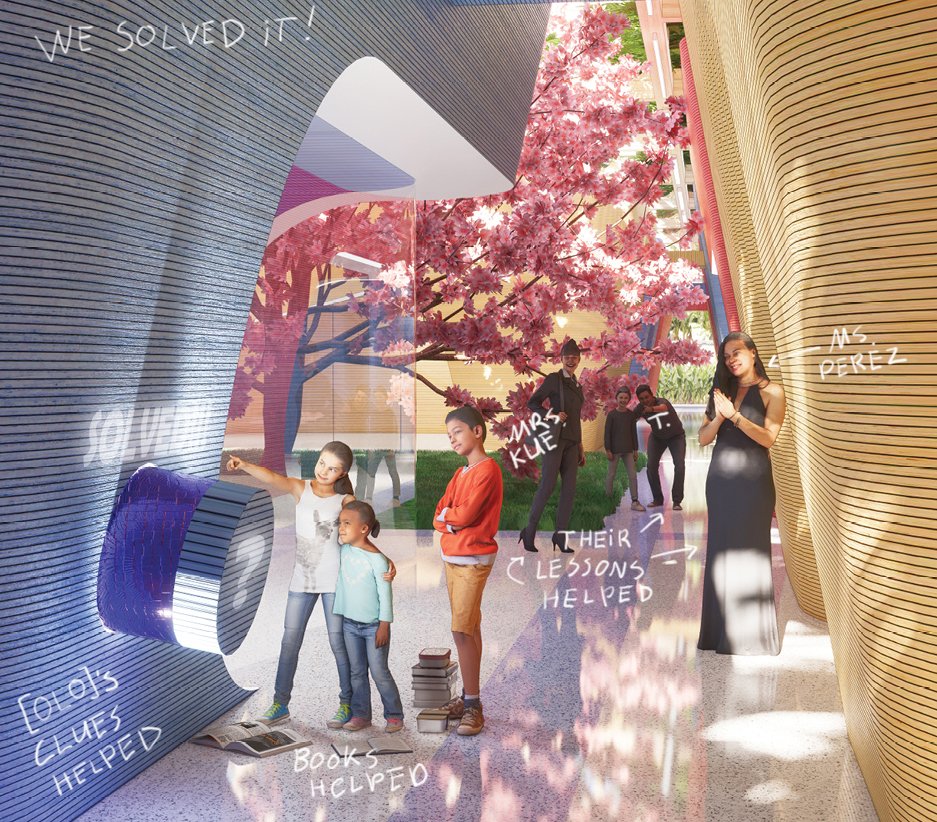Rapson 2023: Theme School
Maxfield Elementary School imagined on its 150th birthday in 2041
School as perceived by a student.
INTRO
Maxfield Elementary faces two big challenges: helping to undo the damage done to the Rondo community, and addressing the crisis of school education in the US. To do that, the school must become a beacon for the community and an inspirational place attracting old and young alike. One of the most successful topologies in creating such places is a theme park: a master of engaging and immersive environments. Therefore, this entry re-imagines Maxfield Elementary in a new hybrid typology - Theme School.
NATURE OF KNOWLEDGE
The school’s theme is the Nature of Knowledge.
On one end, it refers to the primary focus of the curriculum: learning how to learn, which is the nature of knowledge. On the other end, nature empowers knowledge by playing a pivotal role in the school’s climate control, connection to the community, and curriculum.
GREENHOUSE & PLANTERS
To keep up with the ever-changing world and educational trends, the school must be incredibly flexible. Therefore, the new Maxfield Elementary is a greenhouse filled with inhabitable mobile planters. The planters are 3d printed (and recycled) on-site. This allows the school to produce updated classrooms and change the configuration cheaply and quickly.
The greenhouse itself is a CLT structure with most of the roof and the entire façade made of glass. Each CW and skylight is screened by carefully selected plants, transforming the entire building’s envelope into a nature-driven climate control system.
LINKS TO THE COMMUNITY
The school and community are co-dependent in five fundamental ways: through food, water, energy, communication, and shelter.
Food. Each planter has a farm on its rooftop where community members grow edible plants. The produced fruits and vegetables will then be used in the school’s cafeteria. The surplus will go to the community: for example, to the food trucks that also serve the cafeteria.
Water. The water from rain and melted snow are treated on-site and stored in one of the building’s dominants - the water tower. This allows the school to support its ample greenery and also provide clean water for the neighborhood.
Energy. The school’s solar array and wind farms generate 2 GWh of energy per year, enough to power 200 homes. This makes the building net-positive with the extra energy given to the community.
Communication. The school’s second dominant is a radio tower that provides broad-band wireless internet to the community. The future of the school curriculum is hybrid, with some students attending the classes remotely. The school becomes the nexus through which the whole community is connected at all times.
Spaces. The building 3d-prints the diverse spaces for activities and habitation for both the school and the neighborhood: classrooms, businesses, start-ups, and services. It revitalizes the new heart of the Rondo neighborhood on the landbridge and provides it with all the necessary utilities and tools.
CURRICULUM
Living Planters. The building uses game design and [A.I.] to power the learning process. The thematic planters come alive and become living characters with [A.I.] voices. Those artificial characters are tailored by and work hand-in-hand with the community members and teachers to create immersive playing and learning experiences.
Self-driven learning. Through [A.I.] characters, teachers, and game design, the learning becomes self-driven, active, and fun. The building, the grounds, the planters, and the circulation voids between them becomes saturated with secrets, hidden treasures, challenges, quests, and puzzles for children to autonomously discover, overcome and solve. The school’s very architecture is a vehicle for learning.
Applied knowledge. The solutions to quests and puzzles lie in learning more in class and on your own. Knowledge gets directly linked with its application: cracking the school’s secrets. The defeated puzzles and quests will reward the kids and further elaborate on how the acquired knowledge could be applied in the real world.
By the time children graduate, they will be choosing their own goals and will be equipped to face any challenges they come across. They will be ready to embark on the life-long learning quest - their life.
School as perceived by a teacher
![In[form]al](http://images.squarespace-cdn.com/content/v1/62688927ef46ac64011f859d/0609bbb6-516e-420a-a5b7-728a57c1c6a2/Site+Logo.png?format=1500w)




